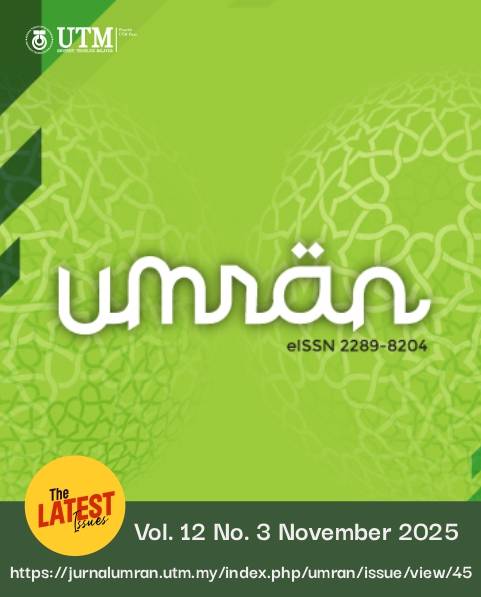Interpretasi Reka Corak Geometri Dalam Iluminasi Dalail Al-Khairat Terengganu/ Interpretation Of Geometric Pattern Design In The Illumination Of Dalail Al-Khairat Terengganu
DOI:
https://doi.org/10.11113/umran2025.12n3.792Keywords:
illumination, geometric patterns, Dalail Al-Khairat, semioticsAbstract
Illumination in Islamic manuscripts is not merely a form of visual decoration, but also serves as an important medium for conveying values and beliefs within Islamic civilization. However, most previous studies have tended to focus on the technical and aesthetic aspects, without deeply exploring the underlying meanings behind the geometric designs used. This gap highlights the need to understand how geometric forms in illumination actually communicate deeper spiritual messages and values. Therefore, this study aims to analyse the variations of geometric patterns found in the illumination of the Dalail Al-Khairat Terengganu manuscript (MSS2586), held in the collection of the National Library of Malaysia (PNM), Kuala Lumpur. This study also discusses the interpretation of the different types of geometric patterns discovered, based on the perspective of Islimi design principles. A qualitative approach was employed, using visual observation and literature review as the main methods. Two illuminated pages with prominent geometric patterns were analysed through a formalistic approach and interpreted using Charles Sanders Peirce’s semiotic theory. The findings reveal that the geometric patterns in this manuscript carry profound meanings related to religious values such as the oneness of God, the balance of nature, and harmony. This study offers significant contributions to the deeper understanding of Malay-Islamic manuscript illumination and highlights its role as a cultural heritage that unites artistic beauty with spiritual values.
References
Annabel Teh Gallop (2017): Audiences and an artist: illumination in Malay literary manuscripts , Indonesia and the Malay World Juornal, 45(132), 146–178. DOI: 10.1080/13639811.2017.1316055
Burak, G. (2021). Prayers, Commentaries, and the Edification of the Ottoman Supplicant. In the Ottoman Empire, c. 1450–c. 1750. OAPEN.
Critchlow, K. (1976). Islamic patterns: An analytical and cosmological approach. Thames & Hudson.
Emad Al Dein Hasan Al Fahmawee (2022). Semiotics As An Approach To The Analysis Of Symbolism In Islamic Architectural Arts. Architecture and Engineering. 7(2), 03–19.
Ensaif, H. H., & Kishor, S. (2025). Symbolism in Islamic Art: An Analysis of Ornamentation and Arabic Calligraphy. Asian Journal of Management, Entrepreneurship and Social Sciences. 5(03), 1-14. DOI: https://doi.org/10.63922/ajmesc.v5i03.1304
Hanash, I. M. (2017). The theory of Islamic art: Aesthetic concept and epistemic structure. The International Institute of Islamic Thought (IIIT).
Hayam Mahdy Salama( 2019) The role of Sacred Geometry in forming Islamic art. Majalah Arsitektur dan Seni, Edisi ke-14 DOI: 10.12816/mjaf.2019.25810
Mohamad Kamal bin Abd. Aziz (2015), Kritikan Seni Dan Identiti Budaya Melayu: Suatu Tinjauan Terhadap Karya Mohamad Hoessein Enas Dan Syed Ahmad Jamal, ICOMHAC2015 eproceedings 16-17 Disember 2015, Century Helang Hotel, Pulau Langkawi UiTM Cawangan Kedah-INSPIN, ms 191-208
Mohd Nur Shafiq Harun & Mohd Samsudin. 2022. Nilai estetika keindahan motif dan corak seni ukiran kayu rumah Limas Belanda di Terengganu [The aesthetic value the beauty of motifs and patterns of wood carving art of Rumah Limas Belanda in Terengganu]. BITARA International Journal of Civilizational Studies and Human Sciences 5(1): 36-51.
Necipoğlu, G. (1995). The Topkapi scroll: Geometry and ornament in Islamic architecture. Getty Center for the History of Art and the Humanities.
Omar, M., Ibrahim, M., Abdullah, I., Yaakub, R., Mohd Razali, H., Md Hashim, S. F., Daud, M. Z., & Jakaria, R. B. (2023). Geometrics in the illumination of Terengganu Quran manuscript (L.M.N.T 2002.1). Al-Irsyad: Journal of Islamic and Contemporary Issues, 8(2), 1107-1118. https://doi.org/10.53840/alirsyad.v8i2.372
Park, J. (2018). Cultural and Mathematical Meanings of Regular Octagons in Mesopotamia: Examining Islamic Art Designs. Journal of History Culture and Art Research, 7(1), 301-318. DOI:http://dx.doi.org/10.7596/taksad.v7i1.1354
Rohidi, T.R. & Husain A.H. (2015). Metodologi penelitian seni. Semarang: Cipta Prima Nusantara.
Saoud, R. (2004). Introduction to Muslim Art. London: FSTC.
Siti Fairuz Md Hashim (2024), Manifestation Of Meaning In National Identity Through Semiotic Theory Approach In The National Day Logo Of Malaysia, Thesis UiTM
Siti Humaini Said Ahmad @ Syed Ahmad, Issarezal Ismail , Muhamad Rozali Othman, Mohd Daud Abdul Rahim, Mohd Nafis Saad (2023), Interpretasi Simbolik Karya Seni Visual Bertajuk Walk in Silence Oleh Saiful Razman Dalam Konteks Fenomena Covid-19 Idealogy Journal, 8(1), 64-74, DOI: https://doi.org/10.24191/idealogy.v8i1.396
Yahya, F. (2021). Illustrated and Illuminated Manuscripts of the Dalāʾil al-Khayrāt from Southeast Asia. Journal of Islamic Manuscripts, 12(3–4), 529–560.
Zahra, F., & Shahir, S. B. (2022), The Spiritual Aesthetics of Islamic Ornamentation and the Aesthetic Value in Islamic Architecture. Journal of Islamic Thought and Civilization 12(1), 116-28.
Downloads
Published
How to Cite
Issue
Section
License
Copyright (c) 2025 Penerbit UTM Press

This work is licensed under a Creative Commons Attribution-NonCommercial-NoDerivatives 4.0 International License.
Copyright of articles that appear in UMRAN - International Journal of Islamic and Civilizational Studies belongs exclusively to Penerbit Universiti Teknologi Malaysia (Penerbit UTM Press). This copyright covers the rights to reproduce the article, including reprints, electronic reproductions or any other reproductions of similar a nature.
















